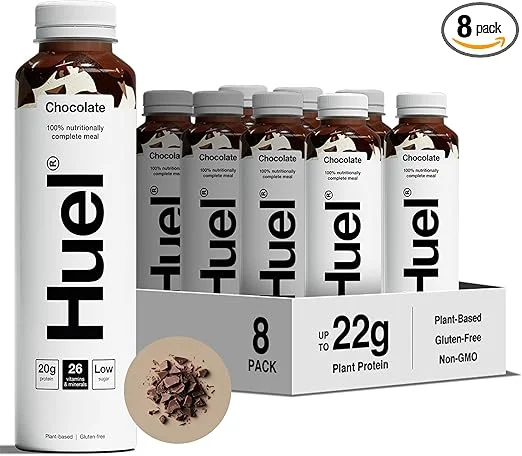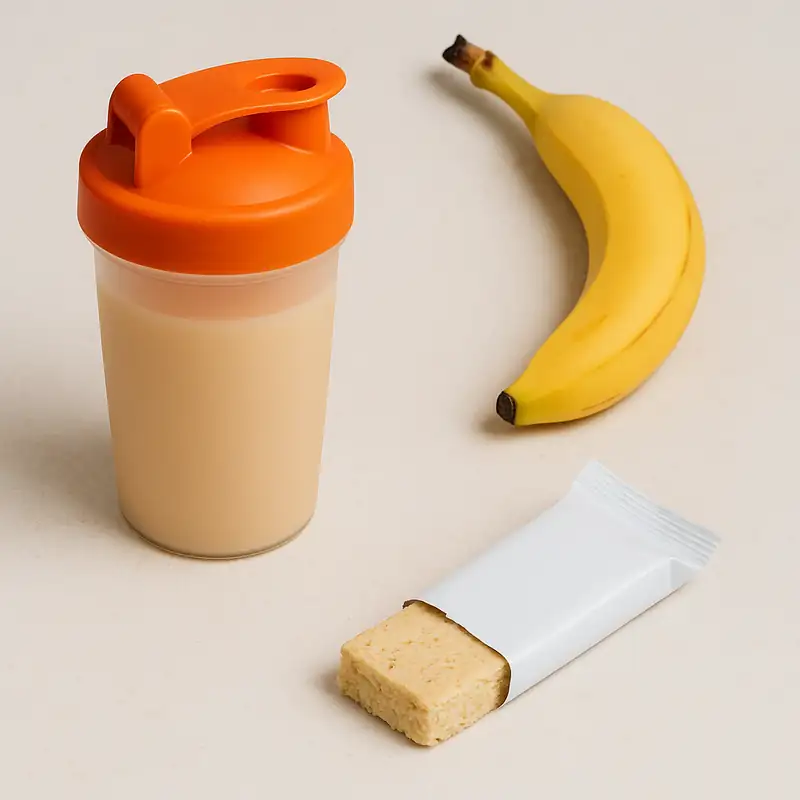Why convenience matters
The pace of modern life isn’t kind to carefully timed meals. A morning that begins with a sprint to catch a train often ends with a late‑night arrival home, punctuated by meetings, school runs and commutes in between. In the chaos, it’s all too easy for nutrition to fall by the wayside. Instead of a balanced lunch, we grab whatever is within arm’s reach. That usually means refined carbohydrates or sugary snacks that leave you hungry again half an hour later. What saves you from this cycle is a bit of planning and a stash of food that can be eaten anytime, anywhere. Keeping portable protein within reach means you’re less likely to skip meals altogether and less prone to those mid‑afternoon slumps that make a biscuit tin look alluring.
Protein does more than simply build muscle. It’s one of the most satiating macronutrients because it triggers hormones that tell your brain you’ve had enough to eat and helps maintain steady blood sugar levels. Having an easy source of protein can make the difference between feeling energised and feeling drained on a hectic day. It doesn’t need to involve elaborate recipes or specialist powders, either. In fact, some of the best options are foods you might already keep in your kitchen. This article explores why so many people in Britain have embraced high‑protein snacks, how to choose between real foods and commercial products, and how to make smart choices that fit your schedule.
The rise of portable protein
Convenience culture has turned the protein category from niche to mainstream. Market research shows the global protein snack sector will be worth around US$4.92 billion in 2025, with annual growth of roughly 9 per cent. Closer to home, shoppers in the UK have been buying more bars, bites and shakes than ever. Grocery data from early 2025 shows sales of these products were nearly half again higher than the previous year and two million British households purchased them. Sports nutrition as a whole is now worth more than £1.1 billion and is growing by 19 per cent year on year. These statistics reflect a shift away from protein being solely the preserve of bodybuilders and gym enthusiasts. Today’s buyers include office workers, parents on the school run and older adults trying to stay active.
The popularity of portable protein reflects wider lifestyle trends. Hybrid working has blurred the boundaries between home and office, leaving many of us juggling commitments in different locations. Food manufacturers have responded by filling supermarket shelves with high‑protein bars, ready‑to‑drink shakes and yoghurt pots alongside the more traditional sandwiches and crisps. Some retailers dedicate entire aisles to high‑protein products. Brands such as Grenade and UFIT are now household names: Grenade accounts for more than half of protein bar sales and an even larger share in convenience stores, while UFIT holds nearly a third of the ready‑to‑drink shake market. Consumers are also reaching for plant‑based and low‑sugar formulations as they look for healthier convenience without sacrificing taste.
Real foods that travel well
While the market is booming, the simplest portable proteins often come without marketing hype. Hard‑boiled eggs, for example, are compact, inexpensive and pack around six grams of protein each along with unsaturated fat, vitamin D and choline. One or two eggs in a small tub make a substantial snack that will keep for hours. A small pot of Greek or Icelandic‑style yoghurt provides around 15–20 grams of protein per cup and can be enlivened with a handful of berries. Cottage cheese offers similar convenience and contains approximately 24 grams of protein per cup. Skyr, an Icelandic‑style yoghurt widely available in the UK, is another portable option with roughly 16 grams of protein in a 150 gram pot. Keep your portions chilled with a freezer pack and you have a mini meal that rivals many commercial shakes.
Plant‑based snacks can be equally satisfying. A cup of edamame beans provides about 18.5 grams of protein along with fibre, and roasted chickpeas contain around 14.5 grams per cup. Nuts and seeds might be small, but they are energy dense. A handful of almonds or pistachios adds roughly six grams of protein plus healthy fats and magnesium. Trail mix that includes seeds and unsweetened dried fruit travels well on long drives or train journeys and gives you a steady release of energy. You can also make savoury snacks by roasting spiced chickpeas or broad beans in batches and storing them in an airtight jar.
Tinned fish is another unsung hero of portable nutrition. A tin of tuna contains about 50 grams of protein per 171 gram serving and can be combined with avocado or mixed into wholegrain crackers for a balanced, satisfying bite. Sardines or salmon deliver similar benefits along with omega‑3 fatty acids. Jerky, whether meat‑based or plant‑based, offers a chewy, shelf‑stable option. Traditional beef jerky contains roughly nine grams of protein per 28 grams, while plant‑based versions made from pulses like black beans provide upwards of 14 grams per 65 gram bag. Do watch the salt and sugar content in some commercially made jerkies and opt for lower‑sodium varieties where possible.
Bars, shakes and other commercial options
It’s impossible to discuss portable protein without acknowledging the explosion of bars and drinks that promise to deliver high doses of protein in one convenient package. Protein bars usually contain 15–20 grams of protein per serving and account for roughly 40 per cent of the global protein snack market. In the UK, the strongest performers dominate the impulse channel: Grenade, for instance, holds around 57 per cent of the bar market overall and more than 70 per cent in the convenience sector. Shakes and bottled smoothies, meanwhile, can provide 20–25 grams of protein per bottle and appeal to people who don’t want to chew their snacks. UFIT, one of the leaders in this space, has expanded its range to include “loaded” bars and flavoured drinks that make protein feel like a treat rather than a chore.
There’s nothing inherently wrong with reaching for a bar or shake, and during a particularly busy week they might be your lifeline. They’re widely available in convenience stores, gyms and vending machines, and the portion sizes are consistent. However, it pays to read the labels. Many high‑protein bars also contain added sugars, artificial sweeteners or fillers to improve texture. Ready‑to‑drink shakes can include emulsifiers or thickeners that some people prefer to avoid. Premium ingredients such as pea isolate, collagen or whey can also make these products more expensive, and price is one of the main reasons some consumers still hesitate to buy them. Treat them as occasional tools rather than dietary staples and choose those with simple ingredient lists whenever possible.
Everyday situations and smart strategies
Adapting to a hectic schedule is easier when you anticipate the pinch points. For early mornings, prepare a small tub of Greek yoghurt with berries the night before. Tuck it into a reusable insulated bag and you have a breakfast you can eat on the bus or at your desk. If you know you’ll be in back‑to‑back meetings until mid‑afternoon, pack a hard‑boiled egg, a handful of almonds and a piece of fruit. Keeping these foods in your handbag or laptop case means you’re less tempted to raid the office biscuit tin when hunger strikes. And if you’re driving for several hours, stopping at a petrol station often limits you to chocolate bars and crisps. A home‑made trail mix or high‑protein wrap can prevent expensive and less nutritious impulse purchases.
Commuters aren’t the only ones who benefit from portable protein. Students often spend long days on campus and may not have access to a fridge. A simple wrap filled with hummus, roasted vegetables and tinned salmon or chickpeas offers fibre and protein without requiring reheating. For parents ferrying children between activities, individual cheeses, yoghurt pouches and portioned nuts can keep everyone energised. Travellers stuck in airports might opt for a ready‑to‑drink shake or grab a protein bar from a newsagent, but planning ahead saves both money and packaging. Post‑gym, a protein shake can aid recovery, but so can a banana topped with peanut butter or a bowl of cottage cheese and pineapple. Variety keeps things interesting and reduces the chance you’ll tire of one type of snack.
Balance, variety and cost
Protein is important, but it’s only one part of a balanced diet. The general guidance for healthy adults is about 0.8 grams of protein per kilogram of bodyweight per day, which equates to roughly 55 grams for an average 70 kilogram person. Those who are very active or trying to build muscle may aim for 1.2–2 grams per kilogram. It’s also vital to include complex carbohydrates, fats, vitamins and fibre. A diet dominated by protein can crowd out other nutrients and become monotonous. Mixing dairy, plant and seafood sources not only covers different amino acids but also introduces a range of flavours and textures. Don’t forget fresh fruit, vegetables and wholegrains, which provide energy and fibre to support your digestion.
Cost is another consideration. Premium high‑protein snacks are often priced higher than their standard counterparts because of the expense of quality ingredients and manufacturing processes. Buying whole foods in bulk and preparing snacks at home can be considerably more economical. For example, a bag of lentils or dried chickpeas costs little and yields multiple servings of roasted snacks. A dozen eggs or a large tub of yoghurt provide several days of grab‑and‑go options at a fraction of the price of individual bars. If you enjoy packaged products, look out for promotions or multipacks in supermarkets, and combine them with home‑prepped options so you’re not reliant on one expensive format.
Putting it all together
Choosing portable protein isn’t about finding a single magic snack; it’s about building a toolkit that suits your lifestyle. Some days you might have time to cook ahead, other days you’ll need to pick up a bar from the corner shop. By understanding how protein keeps you full, recognising how much you need and being aware of what different products contain, you can make decisions that support your health without derailing your day. The British market for high‑protein foods shows no signs of slowing down, and the diversity of options means there’s something for everyone—from high‑performance athletes to busy parents and retirees.
Next time you’re preparing for a hectic week, plan a selection of grab‑and‑go proteins: boil a batch of eggs, portion out nuts and seeds, mix up a jar of overnight oats with Greek yoghurt, or stock up on a couple of your favourite bars. Tuck a tin of tuna into your desk drawer and slip a bag of roasted chickpeas into your travel bag. When hunger strikes, you’ll have nourishing options close at hand. With a little forethought, portable protein becomes less of a novelty and more of a natural part of staying fuelled in a busy world. Good nutrition isn’t reserved for those with ample free time—it’s available to anyone willing to plan ahead and make mindful choices.
Featured On‑the‑Go Proteins

Oreo White Protein Bar

Ready‑to‑Drink
Fuel Up Anywhere
Keep your protein intake convenient with bars and ready-to-drink shakes.
Browse Top Protein BarsFind Meal Replacement Shakes
